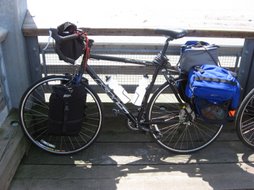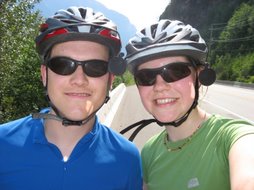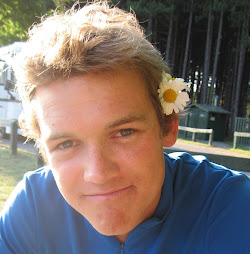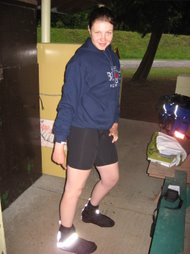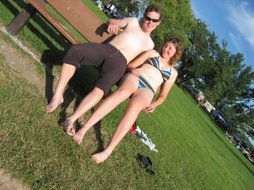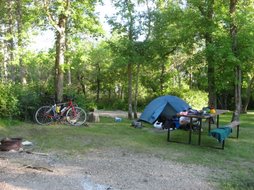Prologue: The Best-Laid Schemes
September 19, 2018: Cambridge to
“This train will terminate at York.”
Shit.
This is not a sentence you want crackling from a PA system when it’s 3:30 p.m. and you’d planned to make it to Inverness by suppertime. Yet here we are, terminated at York. Gales are lashing Scotland and northern England. Overhead lines are down. Some maniac has managed to smash up a Peugeot on the tracks near Berwick-upon-Tweed. No trains will reach Inverness until the next morning, if then.
Joe hatches a demented scheme. A hired car. A rented bike rack. A seven-hour drive. Our Edinburgh-bound Aussie seatmates and their dog-eared Agatha Christie paperbacks for company. Damn the winds of Storm Ali! Full speed ahead!
Agnes proves the wiser. “Here’s a wild idea. What if we just cycle from York to Edinburgh?”
Well, duh.
So the Inverness-Edinburgh cycle tour becomes the York-Edinburgh cycle tour. Perched outside York station, we phone a hotel with room to spare, cycle past the city’s sturdy medieval walls, and drop our things. We wander into town, where choral evensong is just beginning at the Minster—clearly, the Universe is telling us it’s all going to be fine.
 |
| The York Minster, a.k.a. “All that Gothic shit,” in Joe’s artful phrasing. |
Robert Burns, the pride of Scotland, figured that scuppered plans brought “nought but grief an' pain, For promis'd joy!” Pish! York is a pearl and we’re raring to ride by the seat of our pants.
Chapter 1: Mr. Mole
September 20, 2018: York to Osmotherley (route)
“Would you like to hear the world’s hardest crossword clue?”
“Sure!”
“‘Contents of a mail carrier’s bag.’”
We encounter that little riddle in the Golden Lion, an Osmotherley pub, where we’ve secured a cozy table next to the coal stove and Agnes is busy grinding out a tenacious victory on the travel Scrabble board. It’s set for us by the owner of a rickety old dog named Mr. Mole. We learn that, in addition to being a Doctor of Boneology, Mr. Mole tries his paw at Scrabble too on the occasional weekend. Mr. Mole’s owner had jumped in to play referee after Agnes challenged one of Joe’s more hopeful moves (Joe lost) and he then shared some of his genuine Yorkshire warmth and cheer, which included giving us the puzzler above.
The warmth was much needed by that point.
The morning’s ride north out of York had been stunning. The landscape moves quickly into rolling farmland, which glows on a crisp, sunny autumn day, and we’d taken to the open road light-hearted, content with our new plan.
 |
| Yorkshire. Delightful. |
 |
| Cows. |
Lunch in Helmsley turns out lovely. The weather in Helmsley turns from lovely to loathsome. The next six miles are a white-knuckle thrill ride through hills of up to 25% grade—a series of trying climbs followed by screaming downhills around blind corners in the driving wet. Joe skids out on a particularly gnarly hairpin, but manages to stay more or less upright. Agnes struggles to strike a delicate balance: braking hard enough to avoid careening off the road, yet not so hard as to catapult herself over the handlebars. No one dies, but we can’t help but think it no better than happenstance. By Hawnby, we decide to look for a place to dry out.
When imposing yourself on the kindness of strangers, it doesn’t hurt to look like a drowned rat. “Better than you, by the looks of it!” is the response we get when we issue a “how are you?” to the proprietors of the Hawnby tearoom. These kind folk help us call up every inn, hotel, B&B, pub, and hostel within ten miles. They even quip that, as a last resort, we could squat in the local pub that shuttered a few months ago. But no need for that. After about 45 minutes (and a pot of hot tea) we strike gold with a room at the Golden Lion in Osmotherley, about ten miles on.
Those ten miles much resemble the six that sent us scurrying for shelter, but now we know we have soothing ale, warm beds, hot meals, and a hotter hearth awaiting us at the end of the slog.
And, to our surprise and delight, the affable Mr. Mole and his jovial owner.
“Hmm. How many letters?”
“Hundreds.”
Chapter 2: A Horse in the Country; A Rainbow in the Sea
September 21, 2018: Osmotherly to South Shields (route)
“Images of the sea are easy up here, high, images of the sea are what I come for, what I seize upon. What I crave are the long horizons, flat and steel-grey; sometimes a line, a rigid bar, thou shalt not pass: sometimes only a smudge, a blur where sky and water meet and meld with no distinction. Sailors and seagulls bear each other’s souls and nothing is fixed or certain.”
Day two in the saddle begins with a hearty (if late) breakfast and a steep decline into Swainby—our exit point from the North York Moors National Park—which we take at full tilt in the newly dry conditions. After yesterday’s excitement, we welcome a sedate, gentle ride through the string of towns south of Durham. They recall, to our North American ears, the names of fairytale ogres. Crathern. Yarm. Thorpe Thewles. At the last of these, we pick up the National Cycle Network (NCN) Route #1.
Just south of Murton, things get weird. Our path, which had been narrow and rocky, but serviceable, gives way into an open expanse of tarry black goop that sticks to our tires and slows us to a crawl. This is part of the NCN?
We make for the nearest patch of grass and ask a horse for directions.
 |
| This horse did not know the way to Edinburgh. |
NCN 1 guides us into Sunderland—a study in contrasts. South of the River Wear, the old shipbuilding town gives off a gritty, post-industrial vibe. When we cross to the north bank and follow the path along the shoreline toward the sea we find ourself on an open, tiled pathway dotted with public sculpture.

We stop at one particularly poignant installation. A concrete telescope, seat, bag, and notebook containing a poem (“Images of the sea…”) about looking for the things we’ve lost just over the horizon.
As we rejoin the trail, Agnes comments that it’s looking like good rainbow weather. Impeccable timing. We ease past the mouth of the Wear and start heading up the coast when we’re greeted by a majestic double bow beyond the breakwater. The selfie is too blunt an instrument for this task. Time to rope some hapless passerby into taking a real photo.
 The rainbow fades as twilight approaches, signalling the urgency of finding a campsite. First attempt, strike one. In our cursory planning, we’d identified the West Hall Scout Campsite as a likely stopping point, and Google confidently suggested it was open for business. Agnes had been joking about us joining the boy scouts. She was a bit too close to the mark; the site, in fact, turns out to be the headquarters of a boy scout troop and doesn’t look kindly on random adults rolling up looking to camp. Fair enough. No badge in basic background research for us. The scoutmaster sends us instead in the direction of the charmingly named Lizard Lane Caravan Park and Campsite, where we pitch tent, unpack the hexi stove, and fry up the sausages and peppers we’d picked up in Sunderland.
The rainbow fades as twilight approaches, signalling the urgency of finding a campsite. First attempt, strike one. In our cursory planning, we’d identified the West Hall Scout Campsite as a likely stopping point, and Google confidently suggested it was open for business. Agnes had been joking about us joining the boy scouts. She was a bit too close to the mark; the site, in fact, turns out to be the headquarters of a boy scout troop and doesn’t look kindly on random adults rolling up looking to camp. Fair enough. No badge in basic background research for us. The scoutmaster sends us instead in the direction of the charmingly named Lizard Lane Caravan Park and Campsite, where we pitch tent, unpack the hexi stove, and fry up the sausages and peppers we’d picked up in Sunderland.With the basics of food and shelter accounted for, we move to the dilemma posed by the next rung on the hierarchy of needs (the British edition, anyway): trains. Specifically, the lack of them. Our detour in the Howardian Hills and two mornings of late starts means that we remain a good 140 miles from Edinburgh, and neither of us thinks it’s worth trying to pull that off before sundown Saturday. But a combination of line maintenance and industrial action means that all trains north of Berwick-upon-Tweed up to Edinburgh have been replaced by bus service, nixing the option of seeing how far we can get before surrendering the remaining miles to the rails.
The elegant solution presents itself: an early train from Newcastle to Berwick, where we put foot to pedal once more, bringing Edinburgh within reach and avoiding the shame of arriving at our destination under something other than our own power.
Chapter 3: Breads and Butters
September 22, 2018: South Shields to Edinburgh (route)
“Let her finish, Jane!”
The bread is better in the UK. Not the posh bakery bread, necessarily, but the daily-baked bread you can get at any grocery store for a pound or two. This astute observation of Agnes’s has guided our provisioning, and the bread we got from Lidl to go with our sausage and peppers is a case in point. On the train to Berwick-upon-Tweed, we break out the rest of our seed loaf for open-face peanut butter, honey, and banana sandwiches. It’s still rich and fluffy and delicious. Breakfast of champions.
And we’d certainly earned it! We crawled sleepily out of the tent at 4:45, decamped, and cycled to the Newcastle suburban metro by the break of dawn, in time to make a train that got us into Berwick before 9. All fueled up when we disembark in Berwick, we start making our way up the A1. This involves mostly sticking grimly to the shoulder, dodging drainage grates, and pushing against the wind. But we’re rewarded in just a few miles with the Scottish border and, soon afterwards, a turn off the main drag into some stunning Caledonian hills.
The path ahead will make this day our favourite of the three. The cool morning is ideal for our steady climb. When we reach peak altitude, we have a breathtaking view of the path ahead that we can admire while cruising 'round gentle curves on smooth asphalt. Next stop: Dunbar.
 |
| Dunbar Castle |
 |
| Agnes, the heroine of Dunbar |
Hunger vanquished, we face our final leg. Thirty miles into the wind. We narrowly dodge the inconvenience of a less beautiful route when we meet some local day-trippers who point out the path to the coast and assure us that when we get to the train station in Longniddry that yes, we really do need to lug our bikes up the stairs over the pedestrian bridge. Worth it. What a coastline!
 |
| The Longniddry coast |
Man, did I underestimate the Butterses. When we arrive, they show us to a flat within their house that’s bigger than my flat in Cambridge and we take a few minutes to wander around it gawping. I think I got lost for a few minutes somewhere near the grand piano.
 John, it turns out, had read history at Cambridge in the 1950s, become a lawyer, and retired at 49 because cycling is better than lawyering. Jane had become sold on cycle touring after meeting John, and the two of them have spent the better part of the last 30 years collecting cycling stories—both their own and their guests’. They set about collecting ours. Jane is eager to hear every detail of our three-day tour, and can’t help interjecting with stories from their own tours that spring to mind as we talk. John, having heard these not insubstantial digressions before, wants to get back to the main thread of our story—“Let her finish, Jane!” is his soft, but determined admonition. Jane is undeterred. She continues effusing about the joys of cycle touring, as if John wasn’t even there.
John, it turns out, had read history at Cambridge in the 1950s, become a lawyer, and retired at 49 because cycling is better than lawyering. Jane had become sold on cycle touring after meeting John, and the two of them have spent the better part of the last 30 years collecting cycling stories—both their own and their guests’. They set about collecting ours. Jane is eager to hear every detail of our three-day tour, and can’t help interjecting with stories from their own tours that spring to mind as we talk. John, having heard these not insubstantial digressions before, wants to get back to the main thread of our story—“Let her finish, Jane!” is his soft, but determined admonition. Jane is undeterred. She continues effusing about the joys of cycle touring, as if John wasn’t even there. This is clearly a well-worn and practiced interaction, because the result is that we end up talking through the last three days in glorious detail, and the Butterses find numerous points of connection with their own travels. Over dinner and a smorgasbord of Scottish beers, they regale us with stories of their cycle travels across the United States, Europe, and New Zealand. Jane has documented all of these in a series of meticulous, hand-illustrated notebooks, in which she draws the people she meets and relates their stories. The historian in me can’t help but think what an incredible source these are for the sort of day-to-day, slice-of-life experiences of ordinary people that so often don’t make their way into the documentary record.
We have three different desserts. After this high water mark, I’m ruined for Warm Showers forever.
 |
| Our gracious hosts see us off |
After eggs with the Butterses the next morning, our journey ends much as it began: train trouble. The 11 a.m. out of Edinburgh Waverley is cancelled. Then the 12:00 after it. We secure seats on the 12:20, changing in Grantham and then in Ely. We’re half tempted to remove our fates from the hands of the London North Eastern Railway and start cycling home. But our makeshift itinerary eventually gets us back to Cambridge around 6.
The end of this journey is an occasion to reflect on its origins. Some weeks ago, feeling my nose a little too close to the grindstone, I’d resolved to plan a weekend away. “If it were me,” Agnes had said, “I’d go on a cycle tour.” In the spirit of “why not,” I’d agreed to let Agnes school me in the ways of cycle touring and conquer a bit of Scotland in the process. By the end, I was hooked [As Agnes had promised! —AB]. We didn’t, perhaps, follow the route we planned, but we ended up where we needed to be.
(More photos here!)


